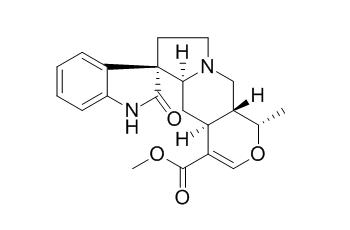Isomitraphylline
Isomitraphylline and pteropodine are the most suitable for standardization of medical cat's claw preparations. Isomitraphylline can inhibit proliferation of acute lymphoblastic leukaemia cells.
Inquire / Order:
manager@chemfaces.com
Technical Inquiries:
service@chemfaces.com
Tel:
+86-27-84237783
Fax:
+86-27-84254680
Address:
1 Building, No. 83, CheCheng Rd., Wuhan Economic and Technological Development Zone, Wuhan, Hubei 430056, PRC
Providing storage is as stated on the product vial and the vial is kept tightly sealed, the product can be stored for up to
24 months(2-8C).
Wherever possible, you should prepare and use solutions on the same day. However, if you need to make up stock solutions in advance, we recommend that you store the solution as aliquots in tightly sealed vials at -20C. Generally, these will be useable for up to two weeks. Before use, and prior to opening the vial we recommend that you allow your product to equilibrate to room temperature for at least 1 hour.
Need more advice on solubility, usage and handling? Please email to: service@chemfaces.com
The packaging of the product may have turned upside down during transportation, resulting in the natural compounds adhering to the neck or cap of the vial. take the vial out of its packaging and gently shake to let the compounds fall to the bottom of the vial. for liquid products, centrifuge at 200-500 RPM to gather the liquid at the bottom of the vial. try to avoid loss or contamination during handling.
Int J Mol Sci.2021, 22(10):5181.
Curr Issues Mol Biol.2023, 45(3):2136-2156.
J Agric Food Chem.2024, 72(49):27139-27149
J Cell Biochem.2024, 125(4):e30537.
Metabolites.2023, 13(6):689.
J Korean Soc Food Sci Nutr2023, 52(11):1101-1110
Pharmaceuticals (Basel).2024, 17(3):352.
Molecules.2020, 25(21):5087.
Front Pharmacol.2016, 7:460
Tropical Journal of Pharmaceutical Research 2021, 20(6):1165-1170.
Related and Featured Products
Biotechnol Lett. 2015 Dec;37(12):2489-96.
Long-term response on growth, antioxidant enzymes, and secondary metabolites in salicylic acid pre-treated Uncaria tomentosa microplants.[Pubmed:
26272395]
To obtain micro propagated Uncaria tomentosa plantlets with enhanced secondary metabolites production, long-term responses to salicylic acid (SA) pre-treatments at 1 and 100 μM were evaluated after propagation of the plantlets in a SA-free medium.
METHODS AND RESULTS:
SA pre-treatments of single node cuttings OF U. tomentosa produced long-term responses in microplants grown for 75 days in a SA-free medium. Reduction in survival rate, root formation, and stem elongation were observed only with 100 μM SA pre-treatments with respect to the control (0 + DMSO).Both pre-treatments enhanced H2O2 and inhibited superoxide dismutase and catalase activities, while guaiacol peroxidase was increased only with 1 μM SA. Also, both pre-treatments increased total monoterpenoid oxindole alkaloids by ca. 55 % (16.5 mg g(-1) DW), including isopteropodine, speciophylline, mitraphylline, Isomitraphylline, rhynchopylline, and isorhynchopylline; and flavonoids by ca. 21 % (914 μg g(-1) DW), whereas phenolic compounds were increased 80 % (599 μg g(-1) DW) at 1 μM and 8.2 % (359 μg g(-1) DW) at 100 μM SA.
CONCLUSIONS:
Pre-treatment with 1 μM SA of U.tomentosa microplants preserved the survival rate and increased oxindole alkaloids, flavonoids, and phenolic compounds in correlation with H2O2 and peroxidase activity enhancements, offering biotechnological advantages over non-treated microplants.
Pharmacol Rep. 2007 Sep-Oct;59(5):565-72.
Antiproliferative activity of various Uncaria tomentosa preparations on HL-60 promyelocytic leukemia cells.[Pubmed:
18048957]
The woody Amazonian vine Uncaria tomentosa (cat's claw) has been recently more and more popular all over the world as an immunomodulatory, antiinflammatory and anti-cancer remedy.
METHODS AND RESULTS:
This study investigates anti-proliferative potency of several cat's claw preparations with different quantitative and qualitative alkaloid contents on HL-60 acute promyelocytic human cells by applying trypan blue exclusion and 3-(4,5-dimethylthiazol-2-yl)-2,5-diphenyltetrazolium bromide reduction assay (MTT).
CONCLUSIONS:
By standardization and statistical comparison of the obtained results pteropodine and Isomitraphylline are indicated to be most suitable for standardization of medical cat's claw preparations.
Br J Haematol. 2006 Mar;132(5):615-22.
Oxindole alkaloids from Uncaria tomentosa induce apoptosis in proliferating, G0/G1-arrested and bcl-2-expressing acute lymphoblastic leukaemia cells.[Pubmed:
16445836]
Natural products are still an untapped source of promising lead compounds for the generation of antineoplastic drugs.
METHODS AND RESULTS:
Here, we investigated for the first time the antiproliferative and apoptotic effects of highly purified oxindole alkaloids, namely isopteropodine (A1), pteropodine (A2), Isomitraphylline (A3), uncarine F (A4) and mitraphylline (A5) obtained from Uncaria tomentosa, a South American Rubiaceae, on human lymphoblastic leukaemia T cells (CCRF-CEM-C7H2). Four of the five tested alkaloids inhibited proliferation of acute lymphoblastic leukaemia cells. Furthermore, the antiproliferative effect of the most potent alkaloids pteropodine (A2) and uncarine F (A4) correlated with induction of apoptosis. After 48 h, 100 micromol/l A2 or A4 increased apoptotic cells by 57%. CEM-C7H2 sublines with tetracycline-regulated expression of bcl-2, p16ink4A or constitutively expressing the cowpox virus protein crm-A were used for further studies of the apoptosis-inducing properties of these alkaloids. Neither overexpression of bcl-2 or crm-A nor cell-cycle arrest in G0/G1 phase by tetracycline-regulated expression of p16INK4A could prevent alkaloid-induced apoptosis.
CONCLUSIONS:
Our results show the strong apoptotic effects of pteropodine and uncarine F on acute leukaemic lymphoblasts and recommend the alkaloids for further studies in xenograft models.
Nat Prod Commun. 2009 Jul;4(7):907-10.
Phytochemical characterization of the leaves of Mitragyna speciosa grown in U.S.A.[Pubmed:
19731590]
Mitragyna speciosa (Rubiaceae) has traditionally been used in the tropical regions of Asia, Africa and Indonesia as a substitute for opium. Indole alkaloids are the most common compounds that have been isolated.
METHODS AND RESULTS:
We investigated the constituents of the leaves of M. speciosa that was grown at the University of Mississippi. Several alkaloids were isolated, including ajmalicine, corynantheidine, Isomitraphylline, mitraphylline, paynantheine, isocorynantheidine, 7-hydroxymitragynine and mitragynine, but their percentages were lower than those in a commercial Thai sample of "kratom". In addition, we isolated the flavonoid epicatechin, a saponin daucosterol, the triterpenoid saponins quinovic acid 3-O-beta-D-quinovopyranoside, quinovic acid 3-O-beta-D-glucopyranoside, as well as several glycoside derivatives including 1-O-feruloyl-beta-D-glucopyranoside, benzyl-beta-D-glucopyranoside, 3-oxo-alpha-ionyl-O-beta-D-glucopyranoside, roseoside, vogeloside, and epivogeloside.
CONCLUSIONS:
This is the first report of the last group of compounds having been isolated from a Mitragyna species. Biological studies are currently underway to test these compounds for opioid activity.



